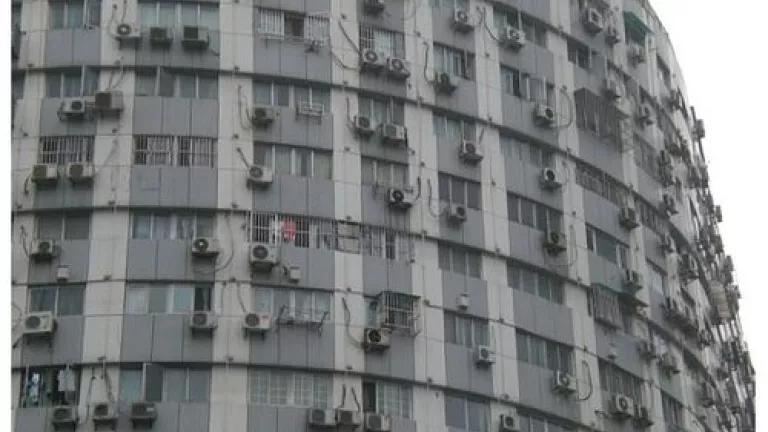In China, Air Conditioning Is Efficient Because of How It's Used, Not Just How It's Built

Americans have grown accustomed to hearing about rapid changes in China, but here is one you might not have thought about before: air conditioning. As I traveled through several of China’s major cities last week—Beijing, Nanjing, Suzhou, and Shanghai—I saw window air-conditioning units everywhere I looked.
This is a recent development. An article in the new OnEarth Magazine says that 20 years ago, less than 1 urban family in 100 had air-conditioning. By 2007, 95 air conditioners were sold for every 100 households.
It turns out, though that an AC is not just an AC. Not only does technology make a difference in how much energy an AC consumes but so does the way people use it: do you want it to be cold enough to wear a sweater and do you want it to get cold instantly, or do you simply want to be comfortably cool when the weather outside is hot?
As I made my way through these Chinese cities, I was told that most of the older houses and apartments had neither air conditioning nor heating until the last few years. In this region, people were accustomed to apartments that were “hot in summer; cold in winter.” Their drafty homes—built with leaky window and no insulation—pretty much reflected the temperature outside.
But lately, almost all the residents of these older buildings have installed window units that provide both heating and cooling. I asked my Chinese colleagues if they were less efficient than central AC or heat. In terms of mechanics, of course, these smaller units are less efficient. But people pay for the electricity they consume themselves and control them individually, so generally these buildings use less electricity than newer ones with central heating and cooling.
Just as we have found in the United States, individual price signals make a huge difference in electricity consumption.
But unlike in America, the temperature on Chinese air conditioners tends to be set much higher. In the United States, the AC in hotels, offices, and stores is usually set so low that I’m glad to have a jacket on. In most places in China, it seems the AC is set at about 77 – 80 degrees F, enough to take the edge off the heat but not enough to give an unpleasant chill.
Fortunately the attire reflects that: most men were in shirt sleeves and only a very few wore suits or jackets. (Unfortunately, I was often one of those few, not wanting to be underdressed in meetings with our partners in NRDC’s clean energy projects.) Accepting more informal attire makes the warmer buildings quite comfortable. I had never thought before of fashion as an important energy efficiency measure.
Air conditioning is becoming the primary driver of electricity use in China’s warmer cities. In Beijing, for instance, air conditioning takes more than 32 percent of the peak electricity load in the summer, while in Jiangsu, it is about 40 percent of peak summer load.
And developers are exploring more efficient ways to keep buildings cool.
The use of ground-source heating and cooling, for instance, is growing in China. This process relies on liquid that is chilled as it passes through underground pipes, taking advantage of the Earth’s constantly cool temperature. Most of the demonstration buildings we visited in China used this form of geothermal energy along with solar panels, and we were told that it is very cost effective. It is not as powerful, however, so the building temperature cannot be changed so quickly. One must be a little more patient with the system than Americans are probably used to.
I have this kind of ground-source cooling in my house, and while it was hard to find a contractor who could competently install it, once it was in, it has provided air conditioning at almost no cost. Likewise, it provides heat using very little electricity.
Of course, the underlying technology of the AC is also critically important. The basic mechanics of American air conditioning have changed very little since the first AC units were invented more than a century ago, the OnEarth article explains. “It’s fair to say that the most state-of-the-art air conditioner today is akin to a gas-guzzling muscle car from 40 years ago,” the author writes.
There is clearly much room for more efficient technology; let’s hope we see some friendly competition in innovation between the US and China and other countries. Clearly there will be a big market for efficient AC.
One final connection: NRDC’s lead green building expert explained to me that AC works by moving heat from inside and dumping it outside. The motors also produce heat. So all that AC is heating the outside even more than it's cooling the inside, overall making the cities even hotter. That’s yet another reason not to keep the AC at home when one’s at work.
This post is part of a series on my recent travels in China. Stay tuned for more posts on China’s efforts to become greener.
